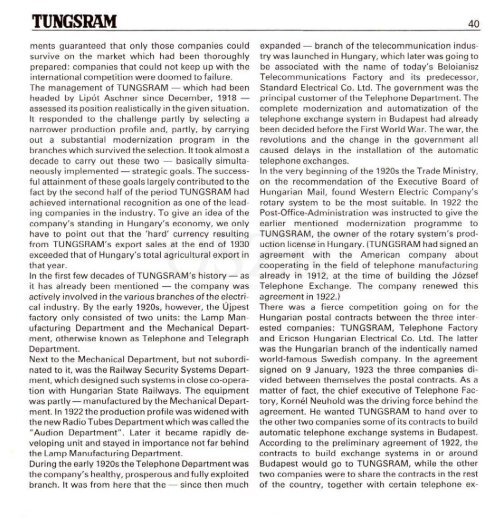THE HISTORY OF TUNGSRAM 1896-1945 - MEK
THE HISTORY OF TUNGSRAM 1896-1945 - MEK
THE HISTORY OF TUNGSRAM 1896-1945 - MEK
- No tags were found...
You also want an ePaper? Increase the reach of your titles
YUMPU automatically turns print PDFs into web optimized ePapers that Google loves.
<strong>TUNGSRAM</strong> 40merits guaranteed that only those companies couldsurvive on the market which had been thoroughlyprepared: companies that could not keep up with theinternational competition were doomed to failure.The management of <strong>TUNGSRAM</strong> — which had beenheaded by Lipot Aschner since December, 1918 —assessed its position realistically in the given situation.It responded to the challenge partly by selecting anarrower production profile and, partly, by carryingout a substantial modernization program in thebranches which survived the selection. It took almost adecade to carry out these two — basically simultaneouslyimplemented — strategic goals. The successfulattainment of these goals largely contributed to thefact by the second half of the period <strong>TUNGSRAM</strong> hadachieved international recognition as one of the leadingcompanies in the industry. To give an idea of thecompany's standing in Hungary's economy, we onlyhave to point out that the 'hard' currency resultingfrom <strong>TUNGSRAM</strong>'S export sales at the end of 1930exceeded that of Hungary's total agricultural export inthat year.In the first few decades of <strong>TUNGSRAM</strong>'S history — asit has already been mentioned — the company wasactively involved in the various branches of the electricalindustry. By the early 1920s, however, the Ujpestfactory only consisted of two units: the Lamp ManufacturingDepartment and the Mechanical Department,otherwise known as Telephone and TelegraphDepartment. -. .Next to the Mechanical Department, but not subordinatedto it, was the Railway Security Systems Department,which designed such systems in close co-operationwith Hungarian State Railways. The equipmentwas partly — manufactured by the Mechanical Department.In 1922 the production profile was widened withthe new Radio Tubes Department which was called the"Audion Department". Later it became rapidly developingunit and stayed in importance not far behindthe Lamp Manufacturing Department.During the early 1920s the Telephone Department wasthe company's healthy, prosperous and fully exploitedbranch. It was from here that the — since then muchexpanded — branch of the telecommunication industrywas launched in Hungary, which later was going tobe associated with the name of today's BeloianiszTelecommunications Factory and its predecessor.Standard Electrical Co. Ltd. The government was theprincipal customer of the Telephone Department. Thecomplete modernization and automatization of thetelephone exchange system in Budapest had alreadybeen decided before the First World War. The war, therevolutions and the change in the government allcaused delays in the installation of the automatictelephone exchanges.In the very beginning of the 1920s the Trade Ministry,on the recommendation of the Executive Board ofHungarian Mail, found Western Electric Company'srotary system to be the most suitable. In 1922 thePost-Office-Administration was instructed to give theearlier mentioned modernization programme to<strong>TUNGSRAM</strong>, the owner of the rotary system's productionlicense in Hungary. (<strong>TUNGSRAM</strong> had signed anagreement with the American company aboutcooperating in the field of telephone manufacturingalready in 1912, at the time of building the JozsefTelephone Exchange. The company renewed thisagreement in 1922.)There was a fierce competition going on for theHungarian postal contracts between the three interestedcompanies: <strong>TUNGSRAM</strong>, Telephone Factoryand Ericson Hungarian Electrical Co. Ltd. The latterwas the Hungarian branch of the indentically namedworld-famous Swedish company. In the agreementsigned on 9 January, 1923 the three companies dividedbetween themselves the postal contracts. As amatter of fact, the chief executive of Telephone Factory,Kornel Neuhold was the driving force behind theagreement. He wanted <strong>TUNGSRAM</strong> to hand over tothe other two companies some of its contracts to buildautomatic telephone exchange systems in Budapest.According to the preliminary agreement of 1922, thecontracts to build exchange systems in or aroundBudapest would go to <strong>TUNGSRAM</strong>, while the othertwo companies were to share the contracts in the restof the country, together with certain telephone ex-








![Letöltés egy fájlban [4.3 MB - PDF]](https://img.yumpu.com/50159926/1/180x260/letaltacs-egy-fajlban-43-mb-pdf.jpg?quality=85)







